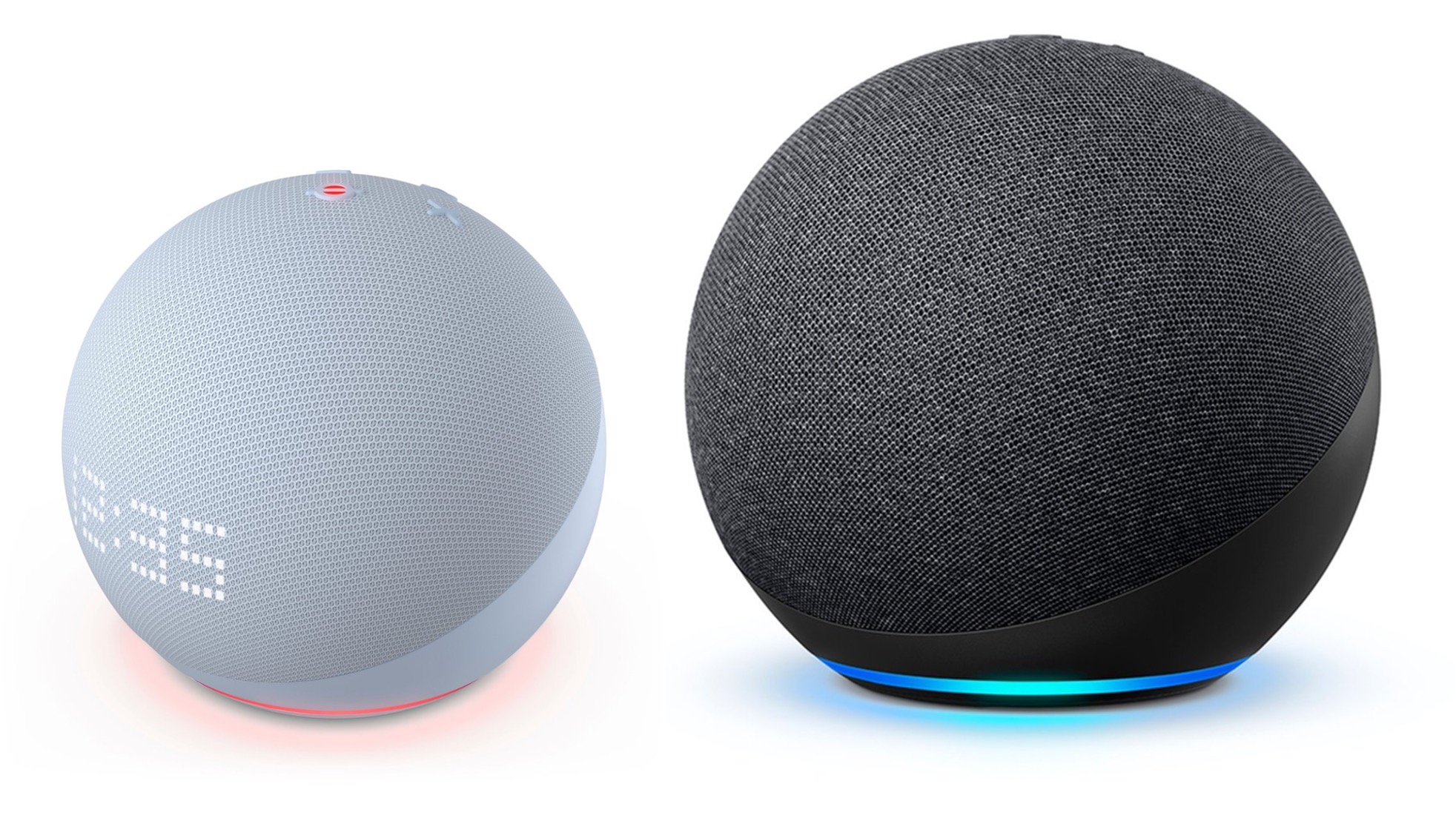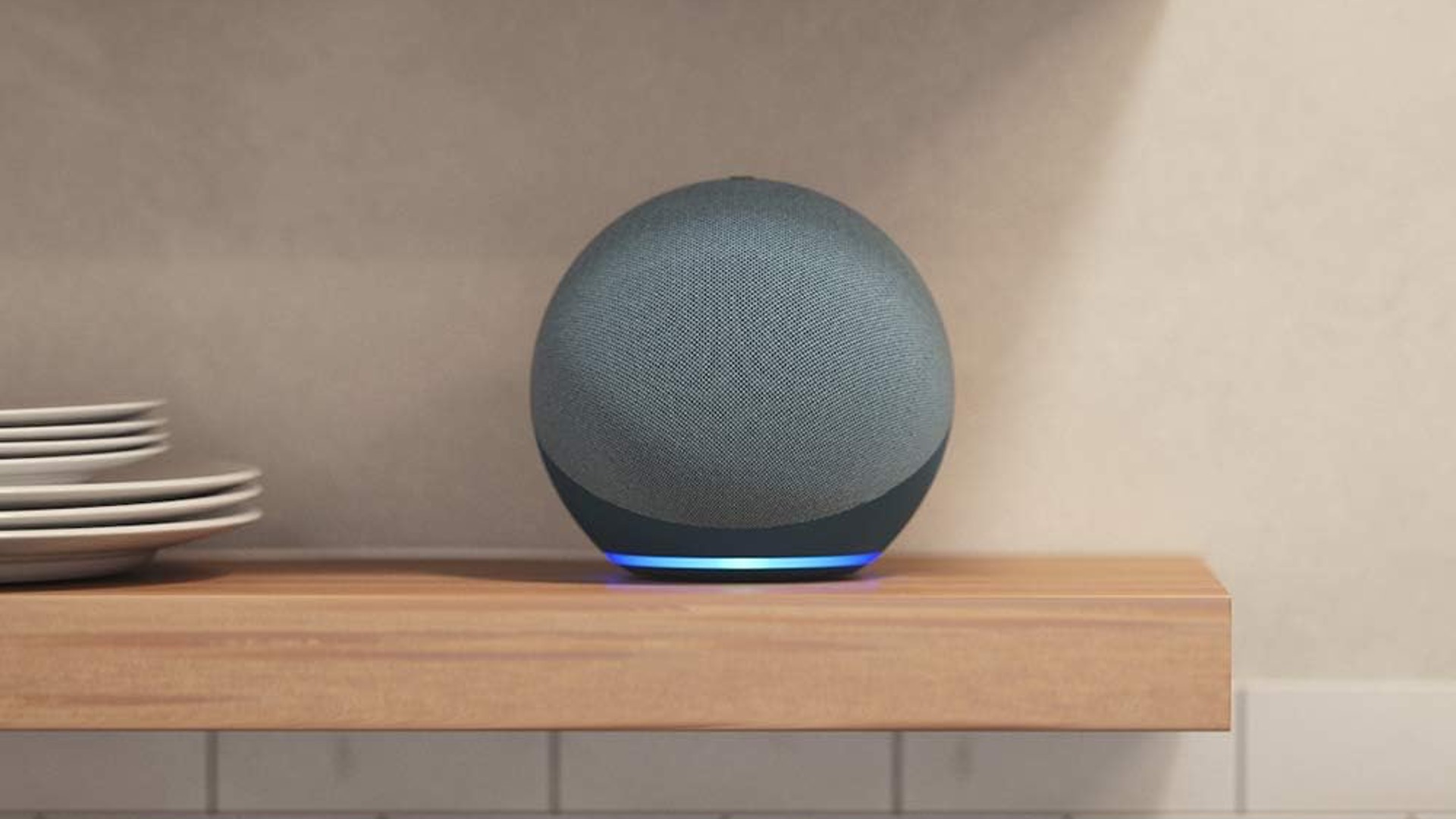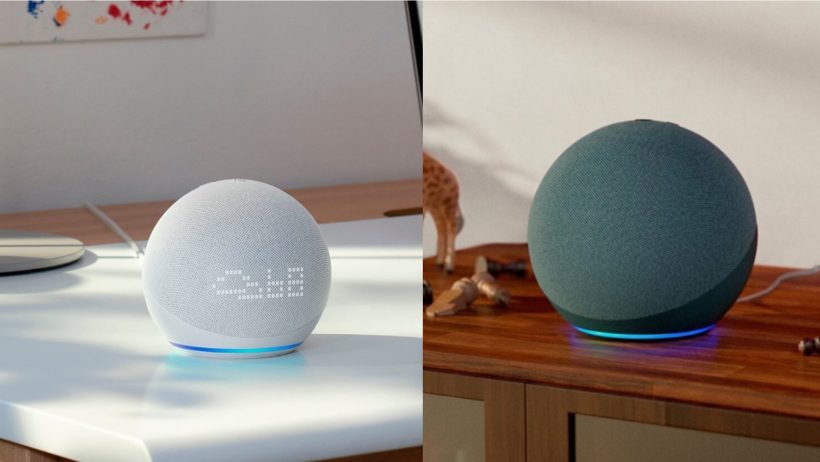The Amazon Echo Dot (5th Gen) and the Amazon Echo (4th Gen) are both smart speakers with Alexa voice assistant capabilities. The Echo Dot is a more compact and affordable option, while the Echo offers a larger and more powerful sound experience. The Echo Dot (5th Gen) features a 1.73-inch speaker, whereas the Echo (4th Gen) is equipped with a 3.0-inch woofer and a pair of 0.8-inch tweeters and delivers louder sound performance with more bass. The Echo (4th Gen) also supports Dolby audio and comes with a 3.5mm line-in/out which makes it a more versatile speaker for home listening.
The Echo (4th Gen) is a much more powerful speaker than the Echo Dot and has better sound quality with a louder 30W output compared to the Echo Dot’s 2.4W.
Comparing the Specs
| Specifications | Amazon Echo (4th Gen) | Echo Dot (5th Gen) |
| Power output | 30W | 2.4W |
| Built-In Speakers | Yes | Yes |
| Number of Microphones | Not specified; features privacy controls including a mic off button | 1; features privacy controls including a mic off button |
| Connectivity Technology | Zigbee, Bluetooth, Wi-Fi | Zigbee, Bluetooth, Wi-Fi |
| Operating System Compatibility | Not specified | Fire OS |
| Voice Assistant Built-in | Alexa | Alexa |
| Power Source | Plug-in; includes power adapter (30W) | Plug-in; includes glacier white power adapter (15W) |
| Temperature Sensor | Yes | Yes |
| Display Screen | No | No |
| Dimensions | 5.30 inches (height) x 5.69 inches (width); Weight: 2.16 pounds (Premium Sound version) | 3.532 inches (height) x 3.937 inches (width); Weight: 0.75 pounds |
| Additional Features | Premium sound, smart home hub, eero Wi-Fi extend, multi-room music | Improved audio for clearer vocals, deeper bass, routines triggered by motion |
The Echo (4th Gen) is designed as a more versatile device with its smart home hub capabilities, premium sound, and built-in Zigbee support for smart home devices. The Echo Dot (5th Gen), on the other hand, is a more compact speaker designed with built-in motion and indoor temperature sensors (this allows you to create routines such as turning on the lights when you walk into a room, or start the fan if the temperature goes above a certain level).

Sound Performance
We felt that the Amazon Echo (4th Gen) delivers better sound quality and more features compared to the Echo Dot. It’s larger than the Echo Dot and includes a built-in Zigbee hub for smart home device integration, allowing you to connect all your smart home devices to the Echo (4th Gen) and use it as a control center. The Echo (4th Gen) is designed to deliver richer and fuller sound with its dedicated woofer and tweeter, delivering crystal clear highs and much better sound performance than the Echo Dot (5th Gen).
Comparing both speakers side by side, the Amazon Echo is the more powerful speaker with 30Ws of output power compared to the Echo Dot’s speaker output (while the amount of watts is not published, it is definitely less than the Echo by a stretch). We played a couple of EDM and rock music soundtracks through both speakers and found that the Echo delivered louder sound and deeper bass notes. Music performances from JVKE’s “Golden Hour” sounded really crisp and clean, with nice vocal ranges and slightly punchy bass on the Echo.
By contrast, the Echo Dot’s sound performance was slightly more muted with recessed highs at higher volume levels. The bass on the Echo Dot speaker was very subtle and you don’t get any low-end beats as compared to the Echo speaker – it feels like the speaker was designed to deliver clear vocals but we wouldn’t say that it delivers sound for music listening. The Echo Dot is designed to reproduce Alexa’s voice with clarity and it can tell the time, temperature or read the news with clarity, but it’s not as effective as the Echo (4th Gen) when it comes to sound performance as it does not deliver any bass and starts to distort at higher volume levels.
While both devices work with Alexa and have similar feature sets, the Echo (4th Gen) is better suited for music listening due to its larger and more advanced speaker configuration (with a dedicated 3” woofer and 0.8” tweeter). On the other hand, the Echo Dot (5th Gen) is a more versatile option for placing in multiple rooms or connecting to existing audio setups for smart home control and voice assistance due to limitations in the Echo Dot’s speaker design.

Specifications & Design
Both the Echo Dot (5th Gen) and Echo (4th Gen) maintain the orb-shaped design with LED base lights and they both blend in nicely with modern home interior décor. The Echo Dot (5th Gen) is more compact, measuring 3.9” x 3.9” x 3.5 and is suitable for smaller spaces. In contrast, the Echo (4th Gen) is about 50% larger at 5.7” x 5.7” x 5.2” and is a much larger speaker and looks more prominent when placed on the table. Both models have top-mounted control buttons and a light ring at the bottom for an interactive listening experience.
The Echo Dot (5th Gen) features a 1.73″ front-firing speaker and is designed to deliver clearer vocals and voice assistance (it does not have any dedicated woofers for bass response). The Echo (4th Gen) speaker is equipped with a 3.0″ neodymium woofer and dual front-firing 0.8″ tweeters for a richer and more dynamic audio experience.
The Echo Dot (5th Gen) is geared towards programming smart home routines with its built-in motion and temperature sensors, allowing for automated routines like turning on lights or adjusting thermostats based on environmental changes. The 5th generation of the Echo dot iteration also supports Eero mesh networks, extending Wi-Fi coverage. However, it lacks a 3.5mm audio output found in the previous generation. On the other hand, we felt that the Echo (4th Gen) smart speaker doubles as a primary sound system (in addition to being a smart speaker) and delivers far better sound performance than the Echo Dot.
Compared with the previous Echo Dot (4th Gen) speaker, the Dot (5th Gen) provides improved mid-range clarity and bass, privacy protection layers, and an optional LED clock in its “Clock” version. However, it does not have a 3.5mm input auxiliary input so you can only stream music through wireless Bluetooth to this speaker.

The Verdict?
The Echo (4th Gen) is a more powerful speaker than the Echo Dot (5th Gen) with louder sound performance, better bass and a more powerful 30W output. It also comes with a dedicated woofer and tweeter and delivers much deeper bass and clearer highs than the Echo Dot. Although both speakers come with virtually the same functionality, including Zigbee hub (for connecting with other smart home devices) and built-in temperature sensors, we felt that the Echo Dot is a speaker designed for voice assistance and delivering the news, temperature or weather forecast rather than for playing music. The Echo is a more advanced speaker that delivers pretty decent sound performance, and is definitely more geared towards those who want a smart home speaker and listen to music at the same time. If you are looking for a speaker that can perform basic functions with Alexa, the Echo Dot (5th Gen) would be a great choice, otherwise the Echo (4th Gen) would be a more versatile option with better sound performance.

